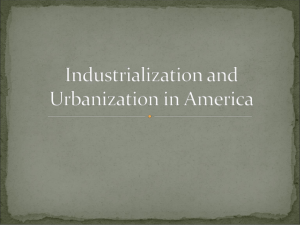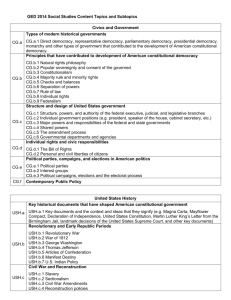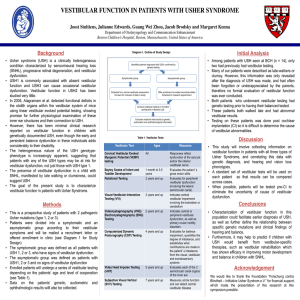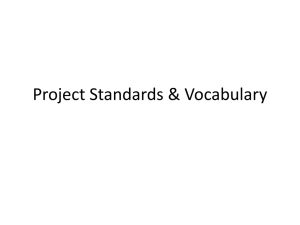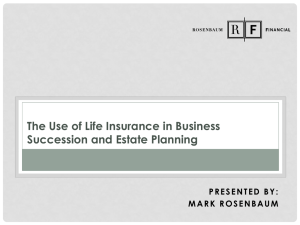Social Studies: United States History, 1877 to the Present Pacing
advertisement
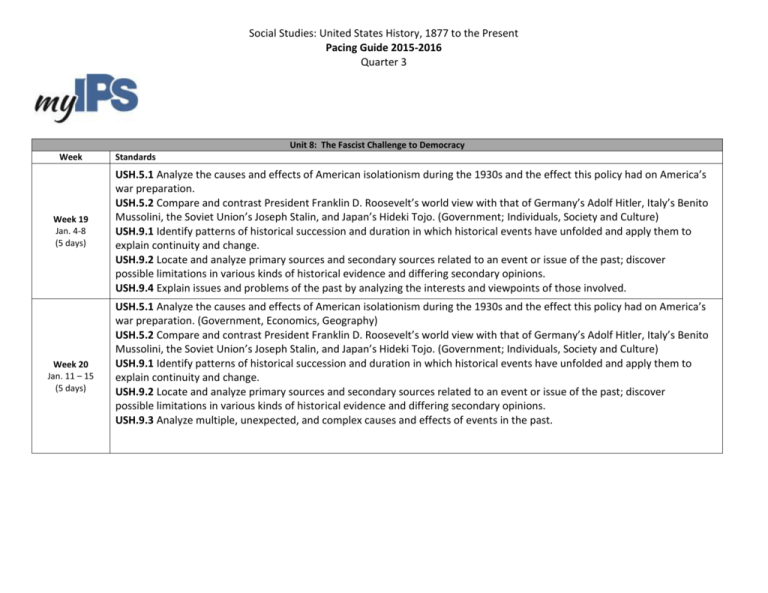
Social Studies: United States History, 1877 to the Present Pacing Guide 2015-2016 Quarter 3 Unit 8: The Fascist Challenge to Democracy Week Week 19 Jan. 4-8 (5 days) Week 20 Jan. 11 – 15 (5 days) Standards USH.5.1 Analyze the causes and effects of American isolationism during the 1930s and the effect this policy had on America’s war preparation. USH.5.2 Compare and contrast President Franklin D. Roosevelt’s world view with that of Germany’s Adolf Hitler, Italy’s Benito Mussolini, the Soviet Union’s Joseph Stalin, and Japan’s Hideki Tojo. (Government; Individuals, Society and Culture) USH.9.1 Identify patterns of historical succession and duration in which historical events have unfolded and apply them to explain continuity and change. USH.9.2 Locate and analyze primary sources and secondary sources related to an event or issue of the past; discover possible limitations in various kinds of historical evidence and differing secondary opinions. USH.9.4 Explain issues and problems of the past by analyzing the interests and viewpoints of those involved. USH.5.1 Analyze the causes and effects of American isolationism during the 1930s and the effect this policy had on America’s war preparation. (Government, Economics, Geography) USH.5.2 Compare and contrast President Franklin D. Roosevelt’s world view with that of Germany’s Adolf Hitler, Italy’s Benito Mussolini, the Soviet Union’s Joseph Stalin, and Japan’s Hideki Tojo. (Government; Individuals, Society and Culture) USH.9.1 Identify patterns of historical succession and duration in which historical events have unfolded and apply them to explain continuity and change. USH.9.2 Locate and analyze primary sources and secondary sources related to an event or issue of the past; discover possible limitations in various kinds of historical evidence and differing secondary opinions. USH.9.3 Analyze multiple, unexpected, and complex causes and effects of events in the past. Social Studies: United States History, 1877 to the Present Pacing Guide 2015-2016 Quarter 3 Week 21 Jan 20-22 (3 days) USH.5.1 Analyze the causes and effects of American isolationism during the 1930s and the effect this policy had on America’s war preparation. USH.5.2 Compare and contrast President Franklin D. Roosevelt’s world view with that of Germany’s Adolf Hitler, Italy’s Benito Mussolini, the Soviet Union’s Joseph Stalin, and Japan’s Hideki Tojo. USH.9.1 Identify patterns of historical succession and duration in which historical events have unfolded and apply them to explain continuity and change. USH.9.2 Locate and analyze primary sources and secondary sources related to an event or issue of the past; discover possible limitations in various kinds of historical evidence and differing secondary opinions. USH.9.4 Explain issues and problems of the past by analyzing the interests and viewpoints of those involved. USH.9.5 Formulate and present a position or course of action on an issue by examining the underlying factors contributing to that issue. Unit 9: America Enters War II Standards Week 22 Jan. 25-29 (5 days) USH.5.3 Identify and explain key events from Versailles to Pearl Harbor that resulted in the United States entry into World War II. USH.5.4 Identify key leaders and events from World War II and explain the significance of each. USH.5.5 Describe Hitler’s “final solution” policy and explain the Allied responses to the Holocaust and war crimes. USH.5.6 Explain how the United States dealt with individual rights and national security during World War II by examining the following groups: Japanese-Americans, African Americans, Native-Americans, Hispanics, and women. USH.9.1 Identify patterns of historical succession and duration in which historical events have unfolded and apply them to explain continuity and change. USH.9.2 Locate and analyze primary sources and secondary sources related to an event or issue of the past; discover possible limitations in various kinds of historical evidence and differing secondary opinions. USH.9.4 Explain issues and problems of the past by analyzing the interests and viewpoints of those involved. Social Studies: United States History, 1877 to the Present Pacing Guide 2015-2016 Quarter 3 Week 23 Feb. 1-5 (5 days) USH.5.3 Identify and explain key events from Versailles to Pearl Harbor that resulted in the United States entry into World War II. USH.5.4 Identify key leaders and events from World War II and explain the significance of each. USH.5.5 Describe Hitler’s “final solution” policy and explain the Allied responses to the Holocaust and war crimes. USH.5.6 Explain how the United States dealt with individual rights and national security during World War II by examining the following groups: Japanese-Americans, African Americans, Native-Americans, Hispanics, and women. USH.9.1 Identify patterns of historical succession and duration in which historical events have unfolded and apply them to explain continuity and change. USH.9.2 Locate and analyze primary sources and secondary sources related to an event or issue of the past; discover possible limitations in various kinds of historical evidence and differing secondary opinions. USH.9.3 Analyze multiple, unexpected, and complex causes and effects of events in the past. Week 24 Feb. 8-12 (5 days) USH.5.4 Identify key leaders and events from World War II and explain the significance of each. USH.5.5 Describe Hitler’s “final solution” policy and explain the Allied responses to the Holocaust and war crimes. USH.5.6 Explain how the United States dealt with individual rights and national security during World War II by examining the following groups: Japanese-Americans, African Americans, Native-Americans, Hispanics, and women. USH.9.1 Identify patterns of historical succession and duration in which historical events have unfolded and apply them to explain continuity and change. USH.9.2 Locate and analyze primary sources and secondary sources related to an event or issue of the past; discover possible limitations in various kinds of historical evidence and differing secondary opinions. USH.9.5 Formulate and present a position or course of action on an issue by examining the underlying factors contributing to that issue. Unit 10: Post-War Society in America Standards Social Studies: United States History, 1877 to the Present Pacing Guide 2015-2016 Quarter 3 Week 25 Feb. 16-19 (4 days) Week 26 Feb. 22-26 (5 days) Week 27 Feb. 29-Mar. 4 (5 days) USH.5.7 Summarize the efforts the national government made to regulate production, labor, and prices during the war and evaluate the success or failure of these efforts. USH.5.8 Identify and describe the impact of World War II on American culture. USH.5.9 Explain how World War II led to the rise of the United States and the Soviet Union as rival superpowers. USH.9.1 Identify patterns of historical succession and duration in which historical events have unfolded and apply them to explain continuity and change. USH.9.2 Locate and analyze primary sources and secondary sources related to an event or issue of the past; discover possible limitations in various kinds of historical evidence and differing secondary opinions. USH.9.4 Explain issues and problems of the past by analyzing the interests and viewpoints of those involved. USH.5.7 Summarize the efforts the national government made to regulate production, labor, and prices during the war and evaluate the success or failure of these efforts. USH.5.8 Identify and describe the impact of World War II on American culture. USH.5.9 Explain how World War II led to the rise of the United States and the Soviet Union as rival superpowers. USH.6.1 Understand the domino theory and its relationship to the principle of containment. Identify key events and individuals as well as their connections to post World War II tensions (Cold War). USH.9.1 Identify patterns of historical succession and duration in which historical events have unfolded and apply them to explain continuity and change. USH.9.2 Locate and analyze primary sources and secondary sources related to an event or issue of the past; discover possible limitations in various kinds of historical evidence and differing secondary opinions. USH.9.3 Analyze multiple, unexpected, and complex causes and effects of events in the past. USH.6.2 Summarize and assess the various actions which characterized the early struggle for civil rights (1945-1960). USH.6.3 Describe the constitutional significance and lasting societal effects of the United States Brown v. Board of Education Supreme Court case. USH.6.4 Summarize key economic and social changes in post-WW II American life. USH.9.1 Identify patterns of historical succession and duration in which historical events have unfolded and apply them to explain continuity and change. USH.9.2 Locate and analyze primary sources and secondary sources related to an event or issue of the past; discover possible limitations in various kinds of historical evidence and differing secondary opinions. Social Studies: United States History, 1877 to the Present Pacing Guide 2015-2016 Quarter 3 USH.9.4 Explain issues and problems of the past by analyzing the interests and viewpoints of those involved. Week 28 Mar. 7-Mar. 11 (5 days Week 29 Mar. 14-Mar. 18 (5 days) USH.6.2 Summarize and assess the various actions which characterized the early struggle for civil rights (1945-1960). USH.6.3 Describe the constitutional significance and lasting societal effects of the United States Brown v. Board of Education Supreme Court case. USH.6.4 Summarize key economic and social changes in post-WW II American life. USH.9.1 Identify patterns of historical succession and duration in which historical events have unfolded and apply them to explain continuity and change. USH.9.2 Locate and analyze primary sources and secondary sources related to an event or issue of the past; discover possible limitations in various kinds of historical evidence and differing secondary opinions. USH.9.4 Explain issues and problems of the past by analyzing the interests and viewpoints of those involved. USH.6.2 Summarize and assess the various actions which characterized the early struggle for civil rights (1945-1960). USH.6.3 Describe the constitutional significance and lasting societal effects of the United States Brown v. Board of Education Supreme Court case. USH.6.4 Summarize key economic and social changes in post-WW II American life. USH.9.1 Identify patterns of historical succession and duration in which historical events have unfolded and apply them to explain continuity and change. USH.9.2 Locate and analyze primary sources and secondary sources related to an event or issue of the past; discover possible limitations in various kinds of historical evidence and differing secondary opinions. USH.9.4 Explain issues and problems of the past by analyzing the interests and viewpoints of those involved. End of Quarter 3 End of the Third Nine Weeks Spring Break March 21 – April 1
